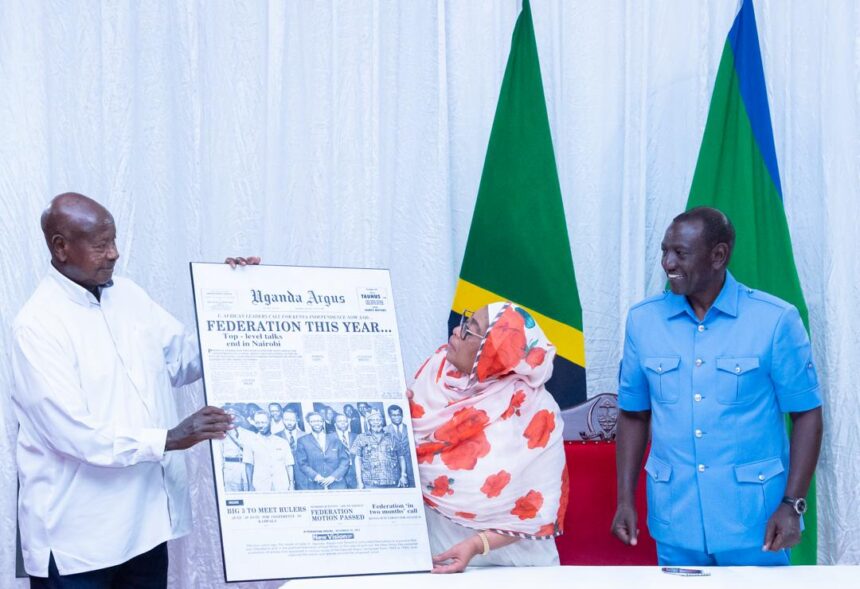On March 14, 2024, the official website of the State House of the United Republic of Tanzania, through its online platform X, released images depicting President Samia Suluhu Hassan in talks with President William Ruto of Kenya and President Yoweri Museveni of Uganda at the Tunguu State House in Zanzibar.
The accompanying captions indicated that one of the key agendas of the meeting among these prominent East African leaders was to discuss expediting the establishment of the East African Federation.
Following the dissemination of this information online, discussions gradually emerged, with people raising various questions regarding the political will of East African Community (EAC) leaders to implement the Federation and the readiness of East African citizens for such a significant political move.
As our leaders deliberate on uniting our nations, it’s imperative to assess whether the citizens of the respective countries possess sufficient understanding of the decisions being made on their behalf. Various studies conducted in countries like Kenya and Tanzania aim to gauge the awareness and sentiments of their populations regarding this pivotal political endeavor.
But before delving into the readiness and awareness of the East African populace regarding the political federation, it’s crucial to understand the concept of Political Federation.
According to the East African Community’s website, Political Federation represents the ultimate goal of regional integration, following the establishment of a Customs Union, Common Market, and Monetary Union.
It is founded on three pillars: common foreign and security policies, good governance, and effective implementation of prior stages of regional integration, as provided for under Article 5(2) of the Treaty for the Establishment of the East African Community.
Are East Africans aware of the process of ‘East Africanisation’?
To answer this question, we must examine various studies conducted in EAC member countries such as Kenya and Tanzania. These countries, being among the oldest and largest within the community in terms of economy, population, territory, and development, provide valuable insights into public sentiment.
The integration journey of the East African Community began in 2005 with the establishment of a customs union, facilitating free trade and common tariffs. Subsequently, in 2010, a common market was established, allowing for the free movement of goods, services, and labor. The ultimate goal is full federation among its eight member states, culminating in the installation of a single central government with unified foreign and security policies.
Despite these efforts, questions remain regarding the awareness and readiness of the populace for this momentous political event. To achieve the political federation, each independent country within the community is required to hold a referendum to solicit and collect people’s opinions on this political endeavor.
To gauge the readiness and sentiments of the people regarding this significant political step within the East African Community, let’s examine the findings of various surveys conducted in member countries:
Kenya – 2022
According to the 2021 Afrobarometer Survey released on August 23, 2022, a significant portion of Kenyans lacks awareness of the East African Federation. Only 22% of Kenyans had heard about it, while 66% had heard nothing at all. Moreover, support for key aspects of integration such as free movement of goods, services, labor, monetary union, and a unitary government is tepid, with many expressing disapproval or ambivalence.
Tanzania – 2008 – 2014
An Afrobarometer survey conducted in 2008 sought the opinions of Tanzanians towards regional integration. A follow-up briefing paper by Research in Poverty Alleviation (REPOA) indicated that a majority of Tanzanians have little or no knowledge of the proposed Federation of the East African States, particularly in rural areas.
However, despite the lack of awareness, a large majority of Tanzanians are positive about the proposed economic aspects of integration, including free movement of people, goods, and services, customs union, and monetary union.
Conclusion
The discussions surrounding the potential establishment of the East African Federation highlight the critical need for EAC governments to prioritize understanding the readiness and awareness of their citizens before proceeding with such a monumental political endeavor. Surveys conducted in Kenya and Tanzania reveal a substantial lack of awareness among the population, particularly in rural areas.
Without sufficient awareness and support from the people, efforts towards political federation may face significant challenges and may not truly reflect the will of the East African populace.
Therefore, it is imperative that EAC governments invest in comprehensive awareness campaigns and consultative processes, including holding referendums, to accurately gauge public opinion.
Only by ensuring that citizens are well-informed and supportive can the EAC move forward confidently towards its goal of political federation, thereby fostering genuine regional integration and prosperity.


